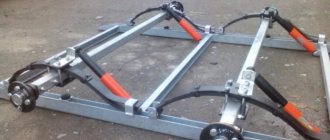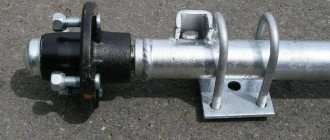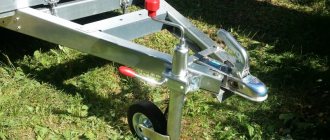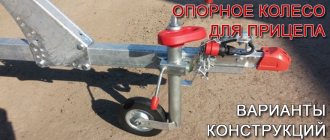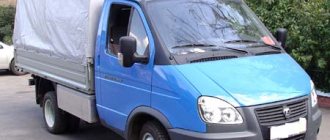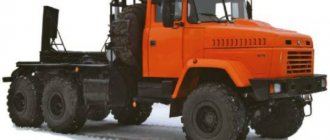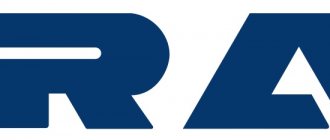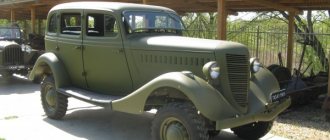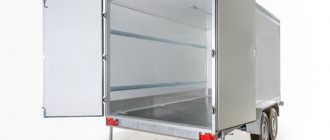Greetings to all! Today we will talk about the locking device, or more simply put, the coupling head of a passenger trailer. What types are there and which one is better to choose in your case. We will also consider operating principles, design options and maintenance methods. And I’ll tell you a little more about accessories for her.
Advice on choosing a coupling head on a new trailer will be unnecessary. Any new trailer is equipped with a good device designed for the required weight. The current information is more suitable for those who are looking for a replacement for an old design. So, let's go..
Fastening elements used in vehicle trailers for all occasions
Each individual type of fastener is characterized by unique strength and reliability indicators. Some samples can be used exclusively for securing small, light loads. Others have an increased strength coefficient and can hold heavy loads and equipment.
You should decide in advance on the most suitable mounting option for the trailer. To do this, you need to carefully consider each variety.
There is a whole list of universal devices that can come to the rescue in a wide variety of situations.
Tightening straps
Previously, strong ropes were used to transport various structures, large materials and equipment. Now the need to use such elements has disappeared. They were replaced by specialized tightening belts. Such products can hold transported items better than others. Preference for tightening straps and ratchets will allow you to securely secure any type of load.
The products are made from durable materials that do not stretch. Most often there are samples equipped with hooks and durable tensioning mechanisms. To secure the belts in the body of a modern trailer, eye nuts are used. Such parts are usually installed by the manufacturer at the assembly stage. Sometimes additional attachment points are required. In this case, such nuts can be installed on the frame yourself.
Belts are used to transport such types of transport as:
- ATV;
- snowmobile;
- motorbike;
- small construction equipment.
How to install a tow bar
Installing a tow bar on a car
The trailer hitch is attached to the frame or body of the vehicle. The bumper is usually removed and its role goes to the main beam of the trailer. In some versions, it is necessary to drill the spar and install embedded plates. But installing a native tow bar is not a difficult task. If the car manufacturer has provided mounting locations, holes and other elements for installing the tow bar, and there is also a document (usually a purchase certificate) with the characteristics of the original device, then self-installation is completely legal and logical. The service will offer a certain price. This will pay off if you plan to drill additional holes or install a non-original towbar, but one that is suitable in terms of characteristics. The service will issue a written conclusion on compliance with the standards.
The condition of the ball and the trailer hitch itself requires constant checking for the presence of:
- Loose, torn nuts or bolts (the grower will prevent loosening, but not tearing);
- Ball lubrication;
- Cleanliness of the outlet;
- Welds.
The ball experiences critical loads and is subject to wear. The diameter must be measured every 1-1.5 thousand kilometers.
ATV Mounts
Among specialized samples, fasteners designed for ATVs are very popular.
The set of accessories includes traps for the front wheels, as well as a locking lock. The advantage of such a mechanism is its ease of maintenance. All elements are quick-release, which greatly simplifies the process of loading and unloading equipment.
Pinout of 15 pin connector
This type of connector for connecting trailers and semitrailers is an accepted standard for tractors from almost all manufacturers, including American ones. Considering the requirements for trailers of this class, a standard 13-pin connector is not suitable for powering and controlling their electrical equipment.
Appearance of a 15 pin socket
Matching table for 15-pin connector.
| Pin number | Coloring | Function |
| 1 | Yellow | Left side turn signal |
| 2 | Green | Starboard turn signal |
| 3 | Blue | PTF |
| 4 | White | Earth |
| 5 | Black | Parking lights on the left side |
| 6 | Brown | Side lights on the right side |
| 7 | Red | Brake light control |
| 8 | Pink | Reverse signal |
| 9 | Orange | +24 V |
| 10 | Gray | Transmission of an alarm signal from sensors installed on the brake pads |
| 11 | White-black | Signal from spring brake pressure sensors |
| 12 | White-blue | Bridge lift control |
| 13 | White-red | exchange of information signals |
| 14 | White-green | CAN-H |
| 15 | White-brown | CAN-L |
Mounts for motorcycles and bicycles
To install two-wheeled equipment on a trailer platform you will need a simple device. The mechanism consists of a special trap that securely holds the wheels and auxiliary parts. Such devices most often include additional stops and belts. Professional devices are equipped with adjustable locking mechanisms.
The same principle applies to mounting bicycles on a platform. The difference is the size of the traps.
How to attach the motorcycle:
Adviсe
- Testing your brake lights can be difficult if you have no one to ask to apply the brakes while you're looking at the trailer lights. If you don't have anyone nearby, you can put a mirror behind the trailer to see from the car if the signals are working. Step on the brake. A red reflection means the brake lights are working. Also be sure to check your turn signals.
- The clamp on the hitch may be very tight to close. A small amount of lubricant will help close the lock with ease.
- Check the reliability of the connection between the towbar ball and the towbar. Raise the trailer tongue to ensure the hitch does not jump off.
For spare wheel
To always carry a spare tire with you, you can equip your trailer with a special mechanism.
The device often has to be made by hand. It is installed on the fork and must consist of a special peg. A threaded pipe can be used. Also quite often, motorists use rotary hubs. The elements allow you to securely attach the spare tire to the trailer.
About the purpose and types of hitch devices for trailers
To connect a towbar to a car, a traction mechanism or a special towing device is required, popularly called a tow bar. This device is designed to ensure reliable attachment of the trailer to the car and is capable of distributing the load evenly.
The towbar ensures safe movement during transportation and has a constructive, pleasant appearance. Previously, the expression towbar could be understood as a suspension device on a cart for transporting various loads on a horse-drawn carriage.
In modern times, a towbar refers to a towing device (TCU) mounted on a vehicle and designed for docking with a trailer.
Towbars are divided into cargo transportation classes:
- Small class, lifting capacity up to 1.5 tons;
- Medium, can carry up to 2.5 tons of cargo;
- Large, weighing up to 3.5 tons.
The latter class is used for transporting transported houses, shopping kiosks and are mounted on SUVs and minibuses. Technologically, the trailer mechanism differs from different manufacturers in appearance and connection design. The towbar has two types of design: European and American. In Russia, a more European type of towbar is used.
Therefore, there are the following types of towbars:
- The towing mechanism in the form of a bracket is capable of providing reliable traction with the trailer and transporting heavy cargo on the trailer. Modifications of models abroad are widespread; there is a locking device to protect against theft;
- Trailed mechanism in the form of a ball. The trailer coupling head is very common in the domestic automotive market; it is easy to install and operate. It has good characteristics in grip and maneuverability, has free movement depending on the head used, and good data when braking with a trailer. The coupling head for a passenger trailer does not externally spoil the appearance of the vehicle and provides some rear protection from an unauthorized direct collision with another vehicle; Depending on the design of the ball, towbars are further divided into subgroups: • welded type ball mechanism with installation for continuous operation and removable ball devices; • bolted, snap-in with lever.
- A trailer hitch in the form of a docking hook, designed for towing. Mainly used for complex, heavy loads that require increased cross-country ability. During the movement, movement with shock loads may occur, which affects the low performance of the towing device. Therefore, they are less reliable and rarely used.
What fasteners can you make yourself?
You can make your own fasteners for the spare tire, for attaching the awning and the fixing point for the belts. This does not require any specific knowledge. All materials can be found in the garage or borrowed from friends.
Example of attaching a spare wheel:
Did you manage to solve your problem using the recommendations from the article?
Yes!
46.39%
No. More answers required. I'll ask in the comments now.
38.56%
Partially. There are still questions. I'll write in the comments now.
15.05%
Voted: 804
Summarize
Well, I wanted to write a short article, but what I ended up with was a detailed report. In short, I would advise you to use two main points from the above. These are “Important selection criteria” and “Repair and maintenance”. Everything else is just an addition.
I'm very glad you read to the end. So the article turned out to be useful. Be sure to rate and write comments. I will be very grateful to you. Thank you and see you in the next article.
Direct connection diagrams
They go where the brake lights are. When removing reflective covers, take into account the minimum pressing of the cushioning foam, which serves to prevent dust from being sucked into the interior. Although there are connection diagrams on the Internet, performing this procedure yourself is not so easy. Before connecting, it would be good to study the approaches to the wires. A nuance: on the one hand, cutting the wiring is too lazy, on the other, it’s a pity. Therefore, for the lazy method, connectors with three ends are provided: two with plugs that connect standard devices, and one end with bare wires to the towbar socket.
In addition, you will need additional materials:
- Socket with cover.
- Switching blocks. They come with fuse sockets.
- Wire with a cross section of 1.5-2 mm square. Insulated stranded or single-core wires are used.
- Silicone automotive sealant.
- Tourniquet. It is a 3-meter corrugated pipe made of plastic or metal.
- Clamps for fixing the harness.
It is not difficult to purchase one set. The factory version requires complex switching for the following reasons:
- Using a smaller load eliminates melting and short circuits;
- Guaranteed proper operation of lighting fixtures.
In theory, 11 wires are placed in a bundle. Since the right and left sides are synchronous, the switching theoretically fits into the usual 7 wires. But in this situation, there are three lamps per core, and this increases the load. There is another way to divide the current into right and left sides. The number of wires, mounting sleeves, and fuses increases. This circuit complies with safety standards.
Conditionally removable ball
The most common towbars for passenger cars have a conditionally removable ball (Fig. 4). Why is it called that? Everything is clear from the name. Such a ball can, of course, be removed from the towbar base. But this requires at least two wrenches and remarkable strength. However, as practice shows, no one almost ever takes them off.
Conditionally removable balls differ in the shape and size of the hook. Its shape depends on the towbar model.
Figure 6. Hook options for a conditionally removable ball
American square
It’s worth mentioning the trailer hitch with an American square ball insert. This type of towbar is installed mainly on SUVs. On some jeeps it is included as standard. There is a Russian manufacturer that specializes in producing just this type of tow bar for passenger cars.
Figure 17. American square trailer hitch
The advantages of such trailer hitches include the fact that it is essentially a designer. You can install a ball of any size and at any height in it. Instead of the insert ball, you can install any additional equipment. For example, a mechanical or electric winch, a footrest, a bike rack, a luggage basket, etc. There is only one disadvantage of this design, in my opinion. No matter how perfectly the insert itself and the beam into which it is inserted are adjusted to each other, there will still be some kind of minimal gap between them. And during acceleration, braking, and simply on uneven roads, impacts from the insert ball will be transmitted to the car body. For some, this drawback is significant. For some, perhaps not. After all, the ability to install additional equipment is sometimes more important than extraneous sounds. However, there are special fingers that eliminate this backlash. I will tell you about the capabilities of American towbars in a separate article.
There is also such a thing as a front tow bar. Usually installed on jeeps participating in “rides”. Used to install a winch or device for transporting long items.
Figure 18. The winch is installed in the front towbar of the car

